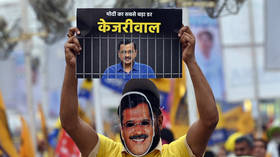High Priests of Music: A spat among classical performers in south India mirrors a local battle in national elections
A controversy around singer TM Krishna, who challenged the ancient caste system and advocated for democratization of classical music, has revealed the essence of a political divide
It’s a story at the intersection of Indian classical music, its age-old caste system of rigid hereditary social classes, and the national elections currently underway. It takes place in India’s deep south, in the state of Tamil Nadu, a state that has been at the forefront of social justice, particularly in electoral politics, and a state from which the center’s ruling Bharatiya Janata Party has historically been shut out. And it begins with a singer.
The Madras Music Academy, an institution that promotes classical Carnatic music (a form of music unique to South India – North India follows Hindustani music), based in Chennai in the state of Tamil Nadu, has lately been torn asunder by a bitter controversy over the announcement of this year’s Sangita Kalanidhi, a prestigious award for excellence in music.
Every December, the Academy holds a month-long festival of music and dance presided over by the year’s Sangita Kalanidhi. In March, it selected eminent Carnatic vocalist Thodur Madabusi Krishna (aka TM Krishna) for the award. The decision has come in for sharp criticism from some senior Carnatic musicians.
These criticisms have all come from Brahmins. Krishna himself is a Brahmin, but has been a social activist, occasionally pushing for the democratization of Carnatic music. This style of music, with roots back in the 3rd century BCE, found its present form in the 14th century. It has always been monopolized by Brahmins.
Brahmins are at the top of Hinduism’s rigid caste pyramid; at the bottom are the dalits, with upper castes and intermediate castes and backward castes in between. India’s caste system had strict social rules of endogamy and eating together. Brahmins had land and knowledge; the dalits did jobs such as disposing of the dead or cleaning “night soil.” In Tamil Nadu, this divide is complicated by the theory that the population is mostly indigenous “darker” Dravidians; the Brahmins are seen as descendants of “light-skinned” Aryan invaders.
After India’s independence, the non-Brahmins slowly took control of politics. Those Brahmins who haven’t fled to the West resent this loss of privilege – and they see TM Krishna as espousing the cause of rationalist-reformer EV Ramaswami Naicker, popularly known as Periyar, who led the Dravidian movement in Tamil Nadu and from whose Dravidar Kazhagam came the Dravida Munnetra Kazhagam (DMK) and the All India Anna DMK (AIADMK).
The DMK and the AIADMK, known as the ‘Dravidian parties’, have alternated in power in Tamil Nadu since 1977, squeezing out the Congress and now the BJP, India’s ruling party since 2014.
Periyar was seen as a Brahmin-baiter but he was hailed by the backward classes and castes, and tribes. Even today he is a revered leader, particularly by the DMK and its supporters, having successfully fought against the practice of untouchability, the persecution of widows, the right to property for women, and reservation in educational institutions and government jobs for the oppressed classes.
The national election currently underway has several interesting sub-battles, and one of them is in Tamil Nadu, where the BJP, supported prominently in Chennai by local Brahmins, is trying to break the Dravidian parties stronghold in state politics.
Academy’s roots in independence
The Music Academy is a landmark institution in the history of the fine arts, emerging as an offshoot of the All India Congress Session held in December 1927 in Chennai as part of the independence movement led by the Congress party. A music conference was held along with it and during the deliberations the idea of founding a music academy evolved.
Inaugurated on August 18, 1928 at the YMCA Auditorium in Chennai’s Esplanade by Sir CP Ramaswami Aiyar, a future prime minister of the princely state of Travancore, it was touted as an institution that would set the standard for Carnatic music. In the process, it began in 1929 the practice of hosting annual conferences on music, which in turn led to the December music festival in Chennai, one of the world’s largest cultural events.
The award to TM Krishna triggered protests by sister-duo Ranjani-Gayatri, who were followed by Trichur Brothers Srikrishna Mohan and Ramkumar Mohan, and exponents of Harikatha (religious discourse), Vishakha Hari and Dushyanth Sridhar. They decided to pull out of the Music Academy’s annual conference in December 2024 to be presided over by Krishna.
N Ravikiran, noted for his prowess in an instrument called chitravina, has decided to return the Sangita Kalanidhi title conferred on him by the Music Academy in 2017.
The aggrieved community
The common thread in the protests is that it is by some Brahmins. Krishna had in the last few years taken up causes relating to secularism (in India, this denotes non-religious practice) and social inclusiveness – he performed for fishermen on a beach along the east coast, and he hit out at caste discrimination by a large section of Brahmins who seek to continue the path of superiority over other castes.
Krishna’s remarks about moving on beyond the realm of Saint Thyagaraja (known for a number of Carnatic songs essentially in Telugu) and M S Subbulakshmi (“the nightingale of India”), were also construed as being irreverent about the legends. In India, unlike ancient Greece, one does not argue with one’s elders.
Krishna has been dubbed an ‘Urban Naxal’, derived from ‘Naxals’ of the ultra-Left Naxalite movement of the late 1960s but now used to denigrate anyone who opposes the right-wing Rashtriya Swayamsevak Sangh (RSS), the parent organization of the BJP.
Music Academy president N Murali on March 21 put his foot down and said there would be no change in the award, and that the choice of Krishna was based on his excellence as a musician, ignoring extraneous factors.
Murali also criticized the protesters for going public with their “vituperative” remarks instead of writing to him, implying that the protesters have chosen to launch a campaign for different (political) reasons.
Social fault lines are also political
Indeed, some of the protesters have been noted for their proximity to the BJP and the RSS, and there is a feeling in music circles that the RSS-Brahmin lobby is behind the protests. Krishna himself remains unfazed.
This campaign has led to a backlash from the Dravidian movement’s current leaders. They have not missed the opportunity to hail Krishna’s efforts to take the music form to the masses and the weaker sections in an easy-to-follow format.
With Krishna around, controversy can never be far behind. He would sing in praise of Allah in traditional Carnatic style. Krishna’s book on the dalit Christian makers of the mridangam, a percussion instrument used in Carnatic music performances, triggered a controversy. Sebastian & Sons: A Brief History of Mridangam Makers highlighted the fact that the percussion instrument was made of cow, buffalo and goat hide, and that the performers, predominantly Brahmin, are shielded from the manufacturing process that involves cow slaughter.
“The cow is removed from the artist’s sight. Since the killing and skinning happen beyond his circle of existence, he can act as if it does not happen,” reads the excerpt titled ‘Keeping the cow and brahmin apart’: “The maker stands at the threshold, keeping the cow and the brahmin apart, helping the latter maintain his ‘purity’.”
Kalakshetra, a premier institution for the fine arts, initially agreed to hold the book release at its Chennai campus but withdrew permission. Director Revathi Ravichandran said the excerpts in the media contained “certain statements relating to the book which touch controversial issues and certainly have a lot of political overtones.”
Tradition of social reform in India
Krishna is seen as a social reformer, trying to bring in changes in the Brahmin community. He is clearly inspired by the tales of Raja Ram Mohan Rai (1772-1833), founder of the Brahmo Samaj, who though a Brahmin, spearheaded campaigns particularly against the practice of Sati (ritual burning of widows upon the funeral pyres of their deceased husbands) in the Brahmin community.
Dr. Babasaheb Ambedkar, who chaired the writing of the Indian Constitution, quit Hinduism and asked his followers to embrace Buddhism. Jainism and Buddhism too emerged in India as offshoots of Hinduism. The Brahmin movement is now under a microscope in Tamil Nadu, unwilling to shed the image of pro-BJP-RSS, while those like Krishna from the community, seek a change from discrimination.
Ranjani-Gayatri duo defended their criticism of Krishna by stating that the ‘‘Brahmins were least casteist.”
The initial atmosphere of protests by some Brahmin musicians has now subsided, with the majority of performers wishing to keep away from the constituency. Some also would like to retain their association with the Music Academy, as a concert in its hallowed hall here is something special.
While they do not defend Krishna’s remarks against the Brahmin community, they are of the opinion that there was no need for organized protests as Krishna deserved the award in pure musical terms, and his other remarks need not come into the picture.
Right now, the ideological clash between the right-wing orthodox RSS and the Dravidian movement as represented by the DMK, in the political arena in Tamil Nadu, has spilled over to the music field, and will see a reflection in the electoral arena in the coming weeks.







Comments are closed.